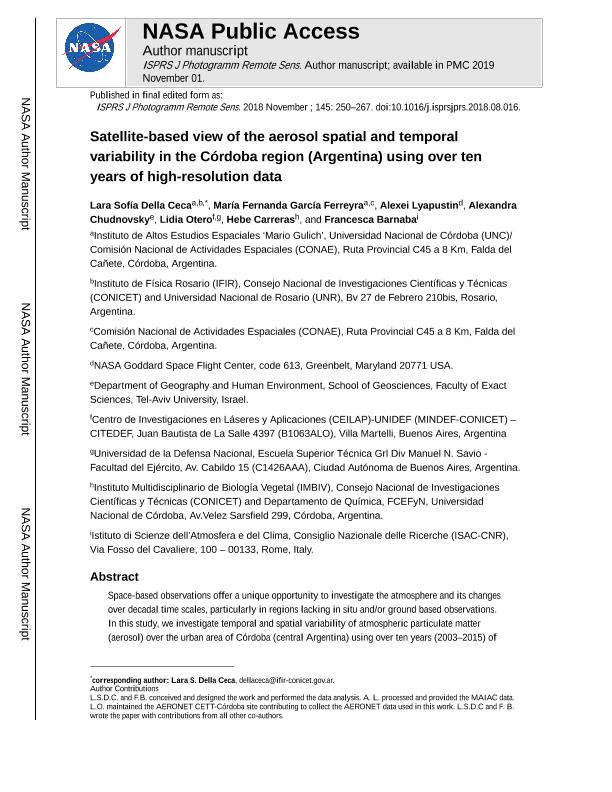Artículo
Satellite-based view of the aerosol spatial and temporal variability in the Córdoba region (Argentina) using over ten years of high-resolution data
Della Ceca, Lara Sofia ; García Ferreyra, María Fernanda; Lyapustin, Alexei; Chudnovsky, Alexandra; Otero, Lidia Ana
; García Ferreyra, María Fernanda; Lyapustin, Alexei; Chudnovsky, Alexandra; Otero, Lidia Ana ; Carreras, Hebe Alejandra
; Carreras, Hebe Alejandra ; Barnaba, Francesca
; Barnaba, Francesca
 ; García Ferreyra, María Fernanda; Lyapustin, Alexei; Chudnovsky, Alexandra; Otero, Lidia Ana
; García Ferreyra, María Fernanda; Lyapustin, Alexei; Chudnovsky, Alexandra; Otero, Lidia Ana ; Carreras, Hebe Alejandra
; Carreras, Hebe Alejandra ; Barnaba, Francesca
; Barnaba, Francesca
Fecha de publicación:
11/2018
Editorial:
Elsevier Science
Revista:
Isprs Journal Of Photogrammetry And Remote Sensing
ISSN:
0924-2716
Idioma:
Inglés
Tipo de recurso:
Artículo publicado
Clasificación temática:
Resumen
Space-based observations offer a unique opportunity to investigate the atmosphere and its changes over decadal time scales, particularly in regions lacking in situ and/or ground based observations. In this study, we investigate temporal and spatial variability of atmospheric particulate matter (aerosol) over the urban area of Córdoba (central Argentina) using over ten years (2003–2015) of high-resolution (1 km) satellite-based retrievals of aerosol optical depth (AOD). This fine resolution is achieved exploiting the capabilities of a recently developed inversion algorithm (Multiangle implementation of atmospheric correction, MAIAC) applied to the MODIS sensor datasets of the NASA-Terra and -Aqua platforms. Results of this investigation show a clear seasonality of AOD over the investigated area. This is found to be shaped by an intricate superposition of aerosol sources, acting over different spatial scales and affecting the region with different yearly cycles. During late winter and spring (August-October), local as well as near- and long-range transported biomass burning (BB) aerosols enhance the Córdoba aerosol load, and AOD levels reach their maximum values (>0.35 at 0.47 µm). The fine AOD spatial resolution allowed to disclose that, in this period, AOD maxima are found in the rural/agricultural area around the city, reaching up to the city boundaries pinpointing that fires of local and near-range origin play a major role in the AOD enhancement. A reverse spatial AOD gradient is found from December to March, the urban area showing AODs 40–80% higher than in the city surroundings. In fact, during summer, the columnar aerosol load over the Córdoba region is dominated by local (urban and industrial) sources, likely coupled to secondary processes driven by enhanced radiation and mixing effects within a deeper planetary boundary layer (PBL). With the support of modelled AOD data from the Modern-Era Retrospective Analysis for Research and Application (MERRA), we further investigated into the chemical nature of AOD. The results suggest that mineral dust is also an important aerosol component in Córdoba, with maximum impact from November to February. The use of a long-term dataset finally allowed a preliminary assessment of AOD trends over the Córdoba region. For those months in which local sources and secondary processes were found to dominate the AOD (December to March), we found a positive AOD trend in the Córdoba outskirts, mainly in the areas with maximum urbanization/population growth over the investigated decade. Conversely, a negative AOD trend (up to −0.1 per decade) is observed all over the rural area of Córdoba during the BB season, this being attributed to a decrease of fires both at the local and the continental scale.
Palabras clave:
Aerosol
,
Air Pollution
,
Argentina
,
Córdoba
,
Maiac
,
Modis
,
Particulate Matter
,
South America
Archivos asociados
Licencia
Identificadores
Colecciones
Articulos(UNIDEF)
Articulos de UNIDAD DE INVESTIGACION Y DESARROLLO ESTRATEGICOS PARA LA DEFENSA
Articulos de UNIDAD DE INVESTIGACION Y DESARROLLO ESTRATEGICOS PARA LA DEFENSA
Citación
Della Ceca, Lara Sofia; García Ferreyra, María Fernanda; Lyapustin, Alexei; Chudnovsky, Alexandra; Otero, Lidia Ana; et al.; Satellite-based view of the aerosol spatial and temporal variability in the Córdoba region (Argentina) using over ten years of high-resolution data; Elsevier Science; Isprs Journal Of Photogrammetry And Remote Sensing; 145; Part B; 11-2018; 250-267
Compartir
Altmétricas



